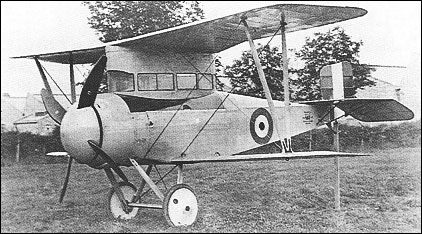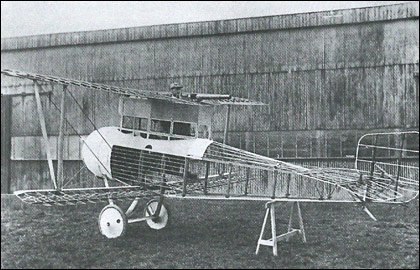|
| Designed by Clifford W Tinson for Frederick Sage &
Company, the Type 2 two-seat fighting scout was of
original concept. Considerable care was taken to reduce
aerodynamic drag, the 100hp Gnome Monosoupape
nine-cylinder rotary engine being fully cowled, a
large propeller spinner being provided and the crew
being accommodated in a fully-glazed cabin. Of conventional
wire-braced wooden construction, the Type 2
was a single-bay biplane with considerable gap, the
upper wing being supported by the cabin structure and
having an aperture above the observer's seat. When
standing to fire his 7.7mm machine gun, the
observer had a wide and clear field of fire. Remarkably
small, the Type 2 had rod-activated ailerons in the
upper wing only. First flown on 10 August 1916, it
proved to possess a very good performance, but gun
synchronization had meanwhile become available, and
after the sole prototype had been wrecked in a forced
landing on 20 September 1916, no attempt was made to
rebuild the aircraft or develop it.
 | A three-view drawing (1278 x 980) |
| WEIGHTS |
| Take-off weight | 701 kg | 1545 lb |
| Empty weight | 404 kg | 891 lb |
| DIMENSIONS |
| Wingspan | 6.77 m | 22 ft 3 in |
| Length | 6.45 m | 21 ft 2 in |
| Height | 2.89 m | 10 ft 6 in |
| Wing area | 15.61 m2 | 168.02 sq ft |
| PERFORMANCE |
| Max. speed | 180 km/h | 112 mph |
| Maurice Flanagan, e-mail, 19.06.2016 19:32 Was Clifford Tinson involved with Bristol Beaufighter and then Helicopter production at Weston Super Mare during and after WW2? reply | | David Tinson, e-mail, 07.09.2011 04:46 Just in case anyone re-looks at this thread I may be able to shed some light. In my grandfathers memoirs, he talks of the Sage 2 aircraft. The Sage 1 crashed due to the pilot at the time turning on the wrong petrol cock, i.e. the reserve one and they ran out of fuel. Sage 2 crashed because of a weak rudder post. A quote from his words: 'My next design, known as Sage 2, was a two seat fighter fitted with a 100hp Gnome engine and was built in 1916. It was not yet possible to fire straight ahead if the gun was mounted on the cowling in front of the pilot because of the propeller and I thought it best to mount a Lewis gun on a scarf ring on top of the centre plane, firing above the propeller and permitting a wide angle of fire as well. I hoped for a speed of 100 mph and at that speed the battering of the slipstream on a gunner standing up to fire would have made it difficult to aim accurately; therefore he must be protected. So I enclosed both pilot and gunner in a glazed structure filling the space between the top of the fuselage and the underside of the upper centre plane, many years before pilots had anything other than a windscreen to protect them...............in any case the introduction of synchronised gun firming gear soon after made such a design as mine unnecessary." He goes on to say: "This machine came to grief through the fracture of the tube forming the rudder post.........We were flying at about 1,000 feet when this happened to us and there were high trees ahead which, with height being lost all the time because of the broken rudder, it was not possible to avoid. We hit the top of one tree swiping off the starboard wings, then another demolished the port wings leaving the rest of the machine to fall down breaking the fuselage in two and finishing it off........We clambered out tof the remains..............with no more damage than a graze and the odd bruise or two.......". I'm not sure where the broken back incident you mention Pete came in but it was not in this one, as to making a 1 /3rd scale model, what great idea and I would happily pass on any info I have. reply | | David Tinson, e-mail, 07.09.2011 04:41 Just in case anyone re-looks at this thread I may be able to shed some light. In my grandfathers memoirs, he talks of the Sage 2 aircraft. The Sage 1 crashed due to the pilot at the time turning on the wrong petrol cock, i.e. the reserve one and they ran out of fuel. Sage 2 crashed because of a weak rudder post. A quote from his words: 'My next design, known as Sage 2, was a two seat fighter fitted with a 100hp Gnome engine and was built in 1916. It was not yet possible to fire straight ahead if the gun was mounted on the cowling in front of the pilot because of the propeller and I thought it best to mount a Lewis gun on a scarf ring on top of the centre plane, firing above the propeller and permitting a wide angle of fire as well. I hoped for a speed of 100 mph and at that speed the battering of the slipstream on a gunner standing up to fire would have made it difficult to aim accurately; therefore he must be protected. So I enclosed both pilot and gunner in a glazed structure filling the space between the top of the fuselage and the underside of the upper centre plane, many years before pilots had anything other than a windscreen to protect them...............in any case the introduction of synchronised gun firming gear soon after made such a design as mine unnecessary." He goes on to say: "This machine came to grief through the fracture of the tube forming the rudder post.........We were flying at about 1,000 feet when this happened to us and there were high trees ahead which, with height being lost all the time because of the broken rudder, it was not possible to avoid. We hit the top of one tree swiping off the starboard wings, then another demolished the port wings leaving the rest of the machine to fall down breaking the fuselage in two and finishing it off........We clambered out tof the remains..............with no more damage than a graze and the odd bruise or two.......". I'm not sure where the broken back incident you mention Pete came in but it was not in this one, as to making a 1 /3rd scale model, what great idea and I would happily pass on any info I have. reply | | Stuart Cotgrove, e-mail, 27.01.2009 21:10 am collecting details on this for a 1 /3rd scale radio control flying model. Would love some more information if anyone has some... reply | |
| | Ali Duncan, e-mail, 05.08.2008 00:15 Fascinating aeroplane. I first saw a picture of one when I was ten, (I'm in my fifties now). I wonder how the crew got in and out though. Any ideas or revelations anyone? reply | | Peter Tinson, e-mail, 05.12.2007 20:42 I am the Grandson of Clifford Tinson and have a piece of propeller which I understand came from an aircraft my Grandfather crash-landed (breaking his back). I wonder if anybody can say if this was the aircraft. reply |
|
Do you have any comments?
|
| 
All the World's Rotorcraft |







